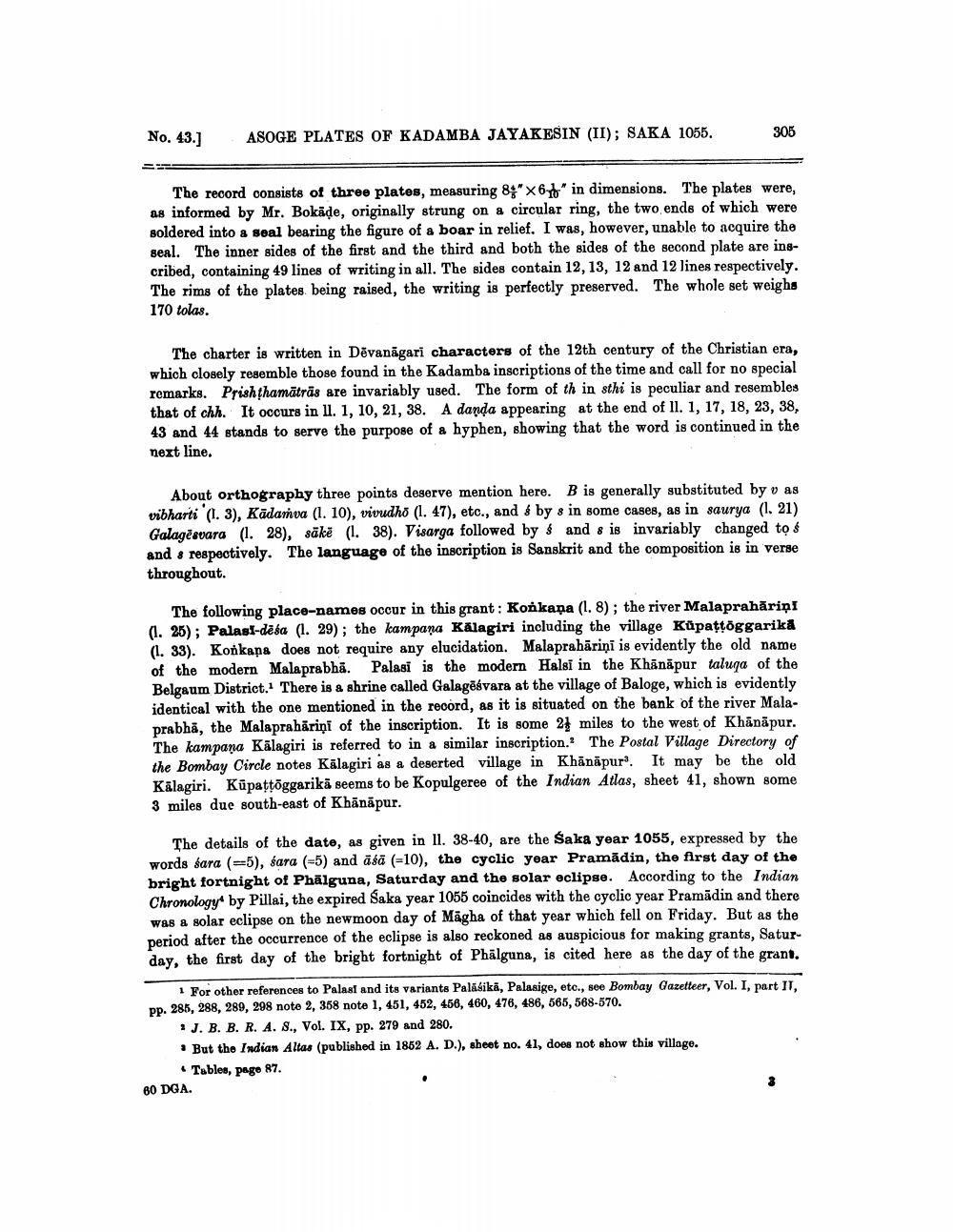________________
No. 43.]
ASOGE PLATES OF KADAMBA JAYAKESIN (II); SAKA 1055.
305
The record consists of three plates, measuring 8"x6" in dimensions. The plates were, as informed by Mr. Bokāde, originally strung on a circular ring, the two ends of which were soldered into a seal bearing the figure of a boar in relief. I was, however, unable to acquire the seal. The inner sides of the first and the third and both the sides of the second plate are inscribed, containing 49 lines of writing in all. The sides contain 12, 13, 12 and 12 lines respectively. The rims of the plates being raised, the writing is perfectly preserved. The whole set weighs 170 tolas.
The charter is written in Devanagari characters of the 12th century of the Christian era, which closely resemble those found in the Kadamba inscriptions of the time and call for no special remarks. Prishthamäträs are invariably used. The form of th in sthi is peculiar and resembles that of chh. It occurs in ll. 1, 10, 21, 38. A danda appearing at the end of 11. 1, 17, 18, 23, 38, 43 and 44 stands to serve the purpose of a hyphen, showing that the word is continued in the next line.
About orthography three points deserve mention here. B is generally substituted by vas vibharti (1. 3), Kādamva (1. 10), vivudho (1. 47), etc., and é by s in some cases, as in saurya (1. 21) Galagèsvara (1. 28), säkě (1. 38). Visarga followed by and s is invariably changed to s and a respectively. The language of the inscription is Sanskrit and the composition is in verse throughout.
The following place-names occur in this grant: Konkana (1. 8); the river Malaprahariņi (1. 25); Palasi-desa (1. 29); the kampana Kalagiri including the village Küpaṭṭöggarikā (1. 33). Konkana does not require any elucidation. Malaprahāriņi is evidently the old name of the modern Malaprabha. Palasi is the modern Halsi in the Khanapur taluqa of the Belgaum District. There is a shrine called Galageśvara at the village of Baloge, which is evidently identical with the one mentioned in the record, as it is situated on the bank of the river Malaprabha, the Malaprahāriņi of the inscription. It is some 2 miles to the west of Khānāpur. The kampana Kalagiri is referred to in a similar inscription. The Postal Village Directory of the Bombay Circle notes Kalagiri as a deserted village in Khanapur. It may be the old Kalagiri. Kupaṭṭoggarikä seems to be Kopulgeree of the Indian Atlas, sheet 41, shown some 3 miles due south-east of Khanapur.
The details of the date, as given in 11. 38-40, are the Saka year 1055, expressed by the words sara (5), sara (-5) and aśä (-10), the cyclic year Pramadin, the first day of the bright fortnight of Phalguna, Saturday and the solar eclipse. According to the Indian Chronology by Pillai, the expired Saka year 1055 coincides with the cyclic year Pramadin and there was a solar eclipse on the newmoon day of Magha of that year which fell on Friday. But as the period after the occurrence of the eclipse is also reckoned as auspicious for making grants, Saturday, the first day of the bright fortnight of Phalguna, is cited here as the day of the grant.
60 DGA.
1 For other references to Palast and its variants Palasika, Palasige, etc., see Bombay Gazetteer, Vol. I, part II, pp. 285, 288, 289, 298 note 2, 358 note 1, 451, 452, 456, 460, 476, 486, 565, 568-570.
2 J. B. B. R. A. S., Vol. IX, pp. 279 and 280.
But the Indian Altas (published in 1852 A. D.), sheet no. 41, does not show this village.
Tables, page 87.




